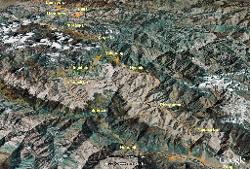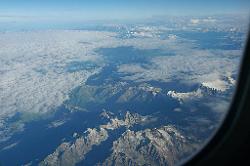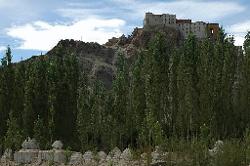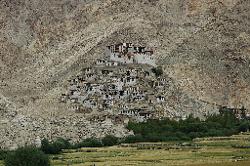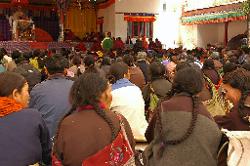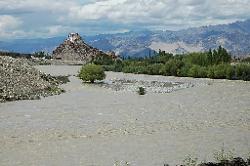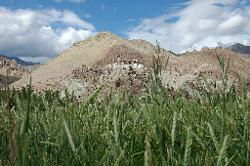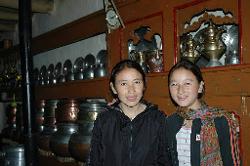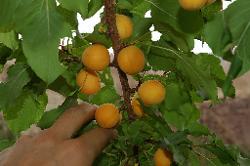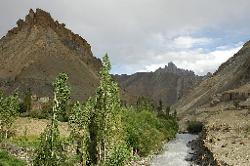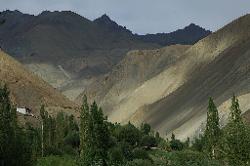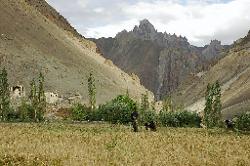MyHimalayasimpressions from |
|
|||||||
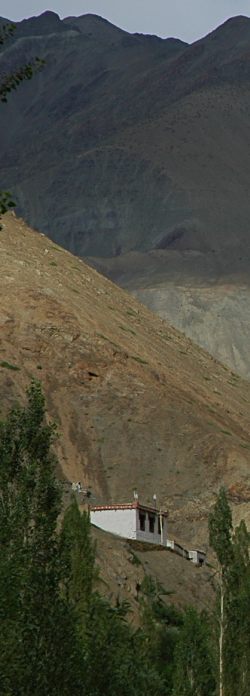
Ladakh to Zanskar: Leh to Panjila
Zurich - Delhi (12 August 2006)
After a decent flight from Zurich (western vegetarian isn't too exciting, and I sleep only little) we circle above the huge city of Delhi for some time. We get through immigration quickly and meet our pick-up. 32° C at midnight and high humidity turns the short walk to the taxi into a sauna experience. 20 minutes later we're in Paharganj, an area in Delhi with reasonable hotels. Hotel Cottage Yes Please is quite nice, we're trying to get some sleep because in a few hours we have to be in the domestic airport again. Flights to Leh are very booked this time of the year, and who gets there late might see his seat being handed to somebody on the waiting list.
Delhi - Leh (Day 2)
At 3.00 in the morning the wake-up call ends a night with few moments of sound sleep, the heat is just too much. At the airport, quite a few people are waiting in line already. After the foiled attacks in London, security is very tight, leading to rather chaotic scenes. Martin, Andrea and I pass through quite smoothly though.
With some delay the plane takes off, there were communication problems with Leh airport and without an account of the weather situation the pilot wouldn't fly. We're in business class, and enjoy an excellent breakfast: dosa with complimentary great views. After half an hour above the flat Ganges plain the first hills appear, followed by glaciers and snow-covered peaks of what must be Himachal Pradesh. The scenery becomes more arid, and through intensifying clouds and mist the ochre hills and mountains of Zanskar appear. Over the Indus valley the fog gets slightly less dense, and green oases dot the side valleys of the mighty river that features a uncommon brown color. Rain in summer has been an exception until 5 years ago. This summer worst flood in decades has effected large areas of Ladakh. Villages, road, fields were destroyed; worse, people died in collapsing houses. It's still very cloudy, strangely the clouds don't come from the Indian plain but from the north-west. Let's hope the worst is over.
At Leh the temperatures are pleasant. After a nap Martin, Andrea and I go for a short stroll to town to fill up water bottles and buy some organic snacks at Dzoma. Then we go to Ibex restaurant for lunch, followed by some more napping at the guesthouse Shynam before heading for dinner at Summer Harvest. A relaxing first day at this altitude is important.
It seems to be a good group (and as it turned out, it really was): Ger and Daireen are from Ireland, Erin and David from the US, Louise is living in England but originally from Australia and has trekked in the Himalayas many times before. Jeff comes from the US, has done trekking in various other places before, unfortunately he fell sick today but will recover for the trek. My friends Martin and Andrea are also from Switzerland, I always wanted to take them trekking but it never worked out. All the people seem friendly, not fussy, and mentally and physically prepared for the 3-week trek.
Leh - Taktok - Chemrey - Leh (Day 3)
I slept well, the weather looks good (in fact it's the best day for weeks), so instead of staying in Leh I plan to visit some monasteries in the Indus valley. Taktok is a relatively remote monastery in the north-east, and started as a small gompa built around a cave where Padmasambhava was meditating on his way to Tibet. Wangchuk will drive, and as always the drive up the Indus is great: he is good company and the scenery is stunning. Along poplar trees and through deserts we pass several monasteries that rise on sharp cliffs above the green valley. We head into a northern side-valley where round fields of barley in various greens and yellows dot the wide valley. The steeper the valley gets, the smaller the fields become. From an impressive position the monastery of Chemrey dominates the valley. Shakti village features long mani walls, much larger and longer than the small village would lead you to expect. A ruined fort above the village might be a sign from the past: a pass (Wangu La) crosses into the Shyok valley from where many trails lead to Central Asia and its fabled trade hubs of Yarkand, Khotan, Samarkand; and from there all the way to Europe and China. Did trade routes pass through Shakti and over Wangu La before the Leh/Kardung La route became so important that the capital was shifted to Leh?
Traktok's old monastery at the cave is closed because the abbot, Rimpoche Tsedul Tsedrung(?), has just arrived from Shimla and the entire village flocked to the new gompa to listen to his speech. People have dressed up and listen intently. After an hour we leave the ceremony to visit Chemrey monastery. At the bottom of the hill stand the houses of the monks, at the very top is the chapel which I think is dedicated to Guru Rimpoche (aka Padmasambhava), a large statue of this famous saint is flanked by 10? others that show his different aspects.
During the afternoon, heavy clouds have gathered in the Zanskar range and are dropping fresh snow on the higher peaks. But at least we've seen some sunlight during the day, the last four weeks were either constant rain or thick clouds.
Leh - Basgo (Day 3)
I hear drizzle when wake up me in the night, but at least not caused by problems with altitude or stomach, but "only" barking dogs (too loud even for my earplugs). Keep fingers crossed.
The gentle rain stops after breakfast; the others are off to visit Phyang and Likir. I've seen both places already, and decide to spend the day in Basgo, stay there for the night and then join the others when driving to the start the trek tomorrow morning.
The drive is nice, weather getting better as we leave the Leh valley and are on the open plain before hitting the Indus again. At the junction of the Zanskar river we stop to enjoy the view over Nimmu where the fields stretch from the organ-pipes of the desert all the way down to the Indus river. Far in the west are the fields of Basgo, the village lies below the bright red crags.
In Nimu we meet Lobsang and the rest of the crew. They are a day ahead of us and on their way to Panjila already in order to set up camp and prepare the trek. Military presence in Nimmu is tight, today is India's Indepence Day, and fear of attacks from "Kashmiri" militants is high. (I use brackets because I'm not sure if they really fight for Kashmir, and not their own political or religious gain. That said, I'm not defending the excesses of the Delhi rule in the valley).
It's only a short drive from here to Basgo through the flat valley. The characteristic red cliffs announce the former capital from far away. The ruined fortress towers above the spread-out houses and the green barley fields which stretch down the side valley of the Indus. We stop at a guesthouse along the road, luckily it is booked; price, location, and owner are not great. After few minutes we find a family that is happy to host me for a night - they clear out the best room on the roof and invite me to have tea. The atmosphere is cozy, great views from the glass-fronted room, and a nearby creek drowns out the unpleasant noises from the road.
Across the creek are patches of fields which contrast sharply with the barren hills. Since most of the bridges were washed away, I takes some time to find one, then I cross and stroll along small water channels through the fields of barley and grass. Despite the slight drizzle it's a wonderful walk, cut a little short by increasing rain and a need for a nap.
The large window front makes the room very warm, and soon I'm off to the land of dreams. I wake up an hour later, the weather is much better and I take another short walk. The sun increases the colors; blue sky, white and black clouds, red cliffs, green fields, and white buildings of Basgo's fort and monastery which are currently being restored. Hoopoe, sparrows, brown doves make the only noise. The walnut-sized apricots straight from the tree taste very refreshing.
In the late afternoon I return to the house, enjoy Ladakhi salt tea, play domino with the daughter who visits class 11 in Leh and speaks good English. Hospitality is overwhelming again; I got offered the best room in the house, am invited to join the family in the living room, and everybody is very friendly and nice. The living room is very spacious, the wall behind the oven contains brass and copper pots, china, vessels. Everything is neatly arranged and polished, clearly the housewife's pride. The family seems relatively wealthy, they own many fields, and some cows and goats. Next to the house is a small vegetable garden where cauliflower, spring onions, spinach is grown. So actually they are probably not rich, but it's just their dignity which makes them seem wealthy - a very clean and nicely decorated house in which an atmosphere and air of satisfaction flows. The way they discuss matters of the day over dinner strikes me as very calm, and dignified. Four generations live in the same house, sharing rooms most of the time and yet not a single angry word or sign of fraction occurs. I wonder when and where arguments arise.
Will the Western way of life roll over them in a few years? I do enjoy Western lifestyle most of the time for myself. But I wonder whether it should really be adopted world wide and become the de-facto standard of living. Do people who were settled in their own culture and were satisfied suddenly become unsatisfied when seeing the propagation of a Western lifestyle constantly, over and over again on TV and radio? Or is it possible to separate the good aspects from the bad ones?
Rice, spinach and kidney beans are a tasty and filling dinner. It's late, almost ten, and I soon fall asleep. A knocking sound wakes me in the middle of the night. I think of a mouse attacking my chocolate, and curse myself for not having closed my bag properly. Then I realize it's water drops, the recent rain has damaged the roof. Luckily it is leaking only a little bit, and no leak is directly above the bed.
Basgo - Alchi - Panjila (Day 4)
Hot sunshine wakes me to a blue sky-ed morning. After a cold shower and chapatti omelets I feel the day has really started.
When the group arrives from Leh, we drive up to the fortress. From up there, the village and its fields look even more picturesque. From the river to the ochre hills lie the green-yellow barley fields, with puffy white clouds floating above the cragged hills. The two temples are quite different, the larger one is being renovated and stands in its own large separate building. Within the complex of the fort is in another room, featuring a large statue that spans over two stories. The paintings on the walls are very old, there's a lot of history contained in this room.
We continue to Alchi monastery which lies in a side-valley to the south. All the fields were harvested already, taking away much charm of the place where one of the few remaining Kashmiri-style paintings can be found. The murals are truly stunning, especially the large mandalas. But lots of tourists and too many shops spoil the atmosphere; I'm glad I stayed in Basgo instead of Alchi.
It will be a long drive to the campsite, and though it is stunning to drive along the Indus, the heat and dusty make it seem even longer. The drive becomes more interesting as the gorge gets more narrow and when we leave the road to Lamayuru the route gets really exciting. Partly because it looks like an area perfect for trekking; colorful cliffs with a grey creek at the bottom evoke thoughts of the next few days. The space between the sheer cliffs and the river becomes more narrow until there's barely room for the road. A monastery atop a hill marks the confluence of two rivers and the opening of the valley. We have reached Wanla, a great village with a fort watching over it. Stacks of hay are spread out to dry behind the white-washed houses. The very end of the valley is marked by high craggy mountains, but before getting close the road ends; we have reached Fanjila. Tents and a herd of horses mark the end of our jeep ride.
Fanjila spreads out along the road, the old part looks very traditional with attached houses climbing up the hills. At the river junction stands a white stupa, our way for tomorrow to Honupata. I don't cross the river, and follow the water channel past the traditional part of the village. The flat spaces are reserved for fields where people are harvesting and cutting barley. Most of it has been spoiled by the rain. A mother and her daughter, owners of the fields from Wanla, have time for a little chat. They finished harvest in their own town, and will be up here for a few days. Most of the men from the village are working elsewhere, and the children are still at school and can't help either. So Nepali laborers are hired to help them in the fields. Some fields are used to grow grass, used as fodder for the cattle during the long winter months.
The door to the small and simple looking monastery is not locked. Behind a glass cage stands one statue, modern-looking thankgas hang on the wall. A single cushion on the floor means there's only one monk taking care of the villagers' spiritual needs.
First dinner of the trek, as always Tenba cooks excellent and with a full stomach I try to fall asleep in the spacious tent. During the day the clouds and wind prevented temperatures from rising too high; it remains warm during the night but as always, the first night in the tent makes it hard to sleep soundly till morning.
| Summary Part 1: The torrential rain has just ended when we arrive in Leh. After some days for acclimatization we drive westwards. It is half a day's drive through spectacular scenery, but I'm happy to arrive in Panjila, the start of our trek. The small village in the narrow but fertile valley is a good starting point. People are harvesting barley above the village which is being watched by a small monastery. |
